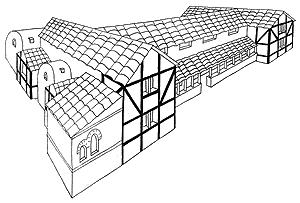
RBH Home
Maps & Travels
Articles
Legends
Towns & Villages
Castles & Houses
Churches
Biographies
Gentry
Family History
Odds & Ends
Mail David
Cox Green Roman Villa
Maidenhead, Bray, Berkshire
 The
Roman villa at Cox Green, on the edge of Maidenhead, was discovered
through aerial photography in the 1950s. It stood just north of the
western end of Northumbria Avenue and was fully excavated in 1959 in
advance of the building of the present housing estate. The site,
surrounded by late 3rd century boundary ditches, 3ft deep, sat alongside
the Lillibrook stream in the fertile Thames Valley, not far from the path
of the old Camlet Way running between Silchester and St. Albans. It was an
ideal spot for agricultural exploitation, as recognised by varying peoples
over the centuries, and the Roman estate may well have been directly
superseded by one of the medieval manors in the area, such as Lillibrook
or Ockwells. As well as farming, by the 4th century, the owners had
diversified into more industrial undertakings. Articles found on the site
include a large array of pottery and kitchenware of many types, a few
items of personal jewellery and miscellaneous bone objects, such as a
gaming counter. The buildings themselves have a complex history as
outlined below.
The
Roman villa at Cox Green, on the edge of Maidenhead, was discovered
through aerial photography in the 1950s. It stood just north of the
western end of Northumbria Avenue and was fully excavated in 1959 in
advance of the building of the present housing estate. The site,
surrounded by late 3rd century boundary ditches, 3ft deep, sat alongside
the Lillibrook stream in the fertile Thames Valley, not far from the path
of the old Camlet Way running between Silchester and St. Albans. It was an
ideal spot for agricultural exploitation, as recognised by varying peoples
over the centuries, and the Roman estate may well have been directly
superseded by one of the medieval manors in the area, such as Lillibrook
or Ockwells. As well as farming, by the 4th century, the owners had
diversified into more industrial undertakings. Articles found on the site
include a large array of pottery and kitchenware of many types, a few
items of personal jewellery and miscellaneous bone objects, such as a
gaming counter. The buildings themselves have a complex history as
outlined below.
Early 2nd Century
The villa seems to have been first erected in the early Antonine period. It was a simple rectangular farm building, 86ft by 26ft, with 3ft thick flint walls aligned north-west to south-east. It mostly consisted of a large single hall, probably used as a kitchen and animal byre as well as a general living area. At the north-western end, a small room was divided of, probably for sleeping accommodation. The entrance was on the north frontage where there appears to have been a wooden veranda.
Late 2nd Century
In the late Antonine period, the small farmstead was expanded to resemble what most people would recognise today as a Roman villa. A long open corridor with a tiled floor was built to replace the veranda. It terminated in two small wings which may have become bedrooms. The original sleeping area had an elaborate hypocaust (underfloor heating system) inserted and was almost certainly transformed into a triclinium (dining room). Meanwhile, the main hall was subdivided into four separate rooms: a large reception area, possibly a pantry, a kitchen (with a hearth) and a bath suite. The latter was entered through the kitchen and was further subdivided into a tiled apodyterium-cum-frigidarium (changing & cold room), with additional plunge bath, a tepidarium (warm room) and a hypocausted caldarium (hot room), also with additional plunge bath. A large stoke room was erected on the southern corner of the building to service this complex. A detached outhouse, 20ft by 15ft, was also built to the north-west. It may have been for livestock, perhaps housing five or six cows.
Possibly Early 4th Century
At an uncertain period, though possibly in the early 4th century, the villa grew to the height of its luxurious elaboration. There were two major new rooms added. One on the north-western end, containing large quantities of iron slag, was used as a forge; the other adjoining the east wing was probably living accommodation required as the family unit expanded. The bath suite was also completely re-fitted. The caldarium (steamy hot room) was converted to a laconicum (sauna-like dry hot room); and the old hot plunge bath, which was too far from a heat-source to keep warm, was replaced by an apsed annex for washing with oil. The old stoke room had a hypocaust inserted and became a new caldarium with the south-western end converted to house a hot plunge bath. An apsed extension was added to the south-east to accommodate a hot water basin and a new stoke room built to the north-west. A subsidiary furnace was also added to the kitchen in order to boost the temperature in the laconicum and tepidarium.
Late 4th Century
Towards the end of the villa's life, changes only occurred to the bath suite which was somewhat simplified. The over-ambitious attempt at providing a laconicum was abandoned, probably due to a lack of success. It can been too close to the cold room and was converted into a tepidarium. The old tepidarium was thus released to become the frigidarum, a new apsed plunge bath being built onto the side; and the changing room now became free of cold-water bathers. The adjoining plunge bath annex was also abandoned and used, for a while, for mixing wall plaster before being sealed and perhaps utilised as a store-room. Occupation continued until at least the last quarter of the 4th century.
Based on the work of C.M. Bennett (1962)
